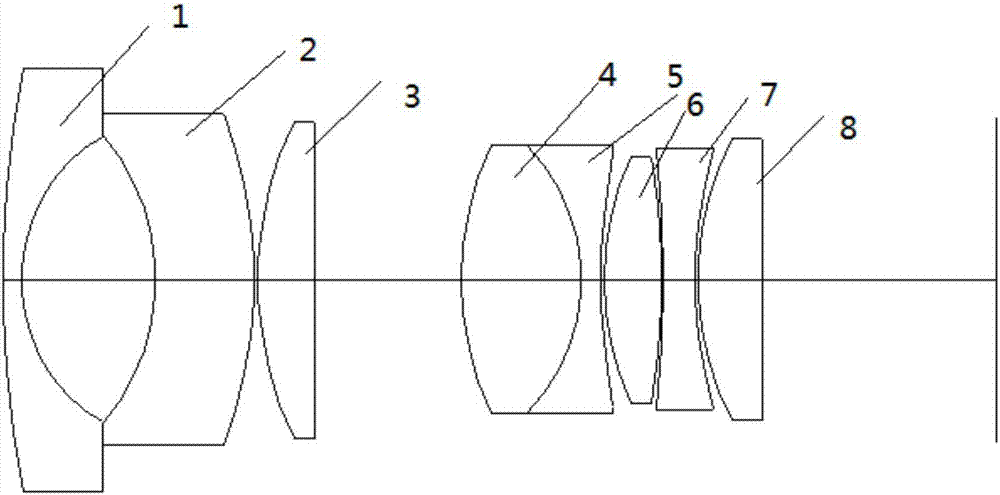Large-aperture 4K prime lens
A fixed-focus lens and aperture technology, applied in the lens field, can solve the problems of increased lens production cost, unfavorable marketing, multi-lens, etc., and achieve the effect of excellent imaging quality, reduced number of lenses, and reasonable price
- Summary
- Abstract
- Description
- Claims
- Application Information
AI Technical Summary
Problems solved by technology
Method used
Image
Examples
Embodiment 1
[0032] Example 1: Please refer to figure 1 , the first lens 1 is a concave-convex negative power lens, the second lens 2 is a concave-convex negative power lens, the third lens 3 is a convex-plane positive power lens, and the fourth lens 4 is A biconvex positive power lens, the fifth lens 5 is a biconcave negative power lens, the sixth lens 6 is a biconvex positive power lens, the seventh lens 7 is a biconcave negative power lens, and the eighth lens 8 is a biconvex positive power lens.
[0033] The parameters of the first lens to the eighth lens are shown in the table below:
[0034] f1=-13.5~-4.5
[0035] Among them, f1 to f8 respectively represent the lens focal lengths of the first lens to the eighth lens in sequence; n1 to n8 represent the refractive indices of the first lens to the eighth lens in sequence; R1, R3, R5, R7, R9, R11, R13, and R15 respectively represent the curvature radii of the surface centers of the first lens to the eighth lens facing the obje...
Embodiment 2
[0045] Example 2: Please refer to figure 2 , compared with Embodiment 1, the number and type of lenses are basically the same, but the specific lens parameters and layout are different.
[0046]The first lens 1 is a concave-convex negative power lens, the second lens 2 is a concave-convex negative power lens, the third lens 3 is a double-convex positive power lens, and the fourth lens 4 is a double-convex lens. A convex positive power lens, the fifth lens 5 is a biconcave negative power lens, the sixth lens 6 is a biconvex positive power lens, and the seventh lens 7 is a biconcave negative power lens, The eighth lens 8 is a biconvex positive power lens.
[0047] The refractive index, focal length and curvature radius parameters of the first lens to the eighth lens are shown in the following table:
[0048] f1=-11.5~-4.5
n1=1.43~1.85
R1=15~200
R2=3.1~8.9
f2=-21.5~-10.1
n2=1.47~1.68
R3=-8.9~-3.1
R4=-40~-4.5
f3=6.5~13.5
n3=1.7~2.1
R...
Embodiment 3
[0054] Example Three: Please refer to image 3 , compared with Embodiment 1, the number and type of lenses are basically the same, but the specific lens parameters and layout are different.
[0055] The first lens 1 is a concave-convex negative power lens, the second lens 2 is a concave-convex negative power lens, the third lens 3 is a double-convex positive power lens, and the fourth lens 4 is a double-convex lens. A convex positive power lens, the fifth lens 5 is a biconcave negative power lens, the sixth lens 6 is a biconvex positive power lens, and the seventh lens 7 is a biconcave negative power lens, The eighth lens 8 is a convex-concave positive power lens.
[0056] The parameters of the first lens to the eighth lens are shown in the table below:
[0057] f1=-11.5~-4.5
[0058] The aspheric coefficients satisfying the above-mentioned aspheric equations in Embodiment 3 are shown in the following table:
[0059]
[0060]
[0061] In this embodiment, the ...
PUM
 Login to View More
Login to View More Abstract
Description
Claims
Application Information
 Login to View More
Login to View More - R&D
- Intellectual Property
- Life Sciences
- Materials
- Tech Scout
- Unparalleled Data Quality
- Higher Quality Content
- 60% Fewer Hallucinations
Browse by: Latest US Patents, China's latest patents, Technical Efficacy Thesaurus, Application Domain, Technology Topic, Popular Technical Reports.
© 2025 PatSnap. All rights reserved.Legal|Privacy policy|Modern Slavery Act Transparency Statement|Sitemap|About US| Contact US: help@patsnap.com



